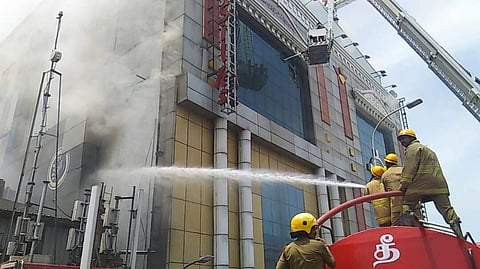Two years after T Nagar fire, is Chennai any safer?
CHENNAI: When the building of a leading textile showroom went up in flames in the heart of Chennai on June 1, 2017, the spotlight was back on over 2,684 buildings in the city that posed a threat to thousands of residents.
These buildings not only violated fire safety norms but were operating without mandatory permissions from the two important agencies – the Department of Fire and Rescue Service (DFRS) and the Chennai Metropolitan Development Authority (CMDA).
The area in question, T Nagar, is clustered with closely packed buildings, violating most of the fire safety norms like setback areas (open space around the building), wide fire staircases and exits, sprinklers and alarm systems among many others.
Two years on and this is still the case with most of the buildings in the city. Stakeholders have been passing the buck, turning a blind eye as unsafe buildings continue to pose serious risks to precious lives and property.
The question is, after such an expensive lesson on the importance of fire safety, why do violations still occur?
The CMDA, which categorises the types of buildings and is in charge of ensuring compliance with the norms, blames the DFRS for any violations. In turn, the DFRS, which is responsible for checking compliance with fire safety systems, points at others for the problems.
“They [builders] just construct without permissions from anybody, we cannot check every building. If it comes to our knowledge, we raise the issue and perform a fire audit. Then we tell them to get a NOC [no-objection certificate], but we don’t have the law in our hands, we can only advise them. The last say is with the CMDA,” said a senior DFRS official.
“The DFRS can write to the Corporation [Greater Chennai Corporation] to cancel their [builder’s] license, it is possible only like that. So more or less the CMDA doesn’t have much power to do anything because we are just engineers concerned with paperwork. The departments in charge of regular monitoring are the Corporation and DFRS,” said a senior official in the Enforcement Cell, CMDA.
Much of the problem lies in the way the agencies have been given mandates and powers. The one with power has no mandate and vice versa.
The DFRS is an advisory body and is responsible for auditing the norms after the construction of the building. However, when it comes to enforcement of the norms and taking action against violators, the responsibility lies primarily with the CMDA.
As officials play a perverse game of passing the parcel with accountability, builders and owners represent the other side of the coin. The complex and ambiguous nature of the rules makes it easy for them to flout the norms and get away with it.
Chennai has stringent fire safety norms that are an amalgamation of the National Building Code of India (NBC), Tamil Nadu Fire Safety Act, 1985, and the CMDA guidelines.
Like the many cooks who spoiled the broth, the varying norms complicate the procedure to the point of ambiguity, which builders are quick to take advantage of.
“The new building code categorises buildings up to 18.30 metres as special buildings, not a multi-storeyed building (MSB). This creates confusion because the NBC does not accept this as a non-MSB and thus it would require fire safety equipment, but the CMDA approves buildings based on their rules,” said Pramod Balakrishnan, a senior architect and founder of Edifice, Chennai.
Explaining how the law contributes to the impunity of builders, Mumbai-based senior architect Anil Noronha said, “If the law was stringent about compensation in terms of loss of life then it would be a different case. But owners and builders have out of court settlements with victims or their relatives, most of whom are poor.”
In 2006, the Madras High Court constituted a Monitoring Committee to look into the issue of regularisation of buildings in Chennai that violated development norms, based on a PIL filed by the Consumer Action Group, represented by senior architect, Tara Murali, against the Tamil Nadu government.
The minutes of the 40th committee meeting show the quality of action taken by the authorities:
“The updated report on the details of enforcement action taken by the local bodies relating to Corporation and Municipalities (that have been received after circulation of agenda and prior to the meeting) continue to reflect the poor performance of the local bodies on the front of the enforcement action.”
“G. N. Chetty Road has a lot of high rise buildings. But with the flyover, the width of the road is insufficient for fire tenders to move. MSBs get their sanctions based on the width of the road in front, but if a flyover is built then the fire tender cannot reach the buildings. But for some strange reason, the width of the road is treated as if it is absolutely clear for MSBs. This is an anomaly which has been pointed out by the DFRS time and time again but for strange reasons, the CMDA takes no cognisance of it,” said Murali, who is a member of the committee.
As one of the employees demonstrated, the now re-opened Chennai Silks building seems to have incorporated most of the fire safety measures. And when asked about mock fire drills, he mentioned that the building management conducts one every week.
According to the norms, a fire officer from the nearest fire station must be consulted while conducting fire safety drills. However, a firefighter at the T Nagar fire station said that no such fire drill has been conducted.
This is but indicative of the scale of the problem.

